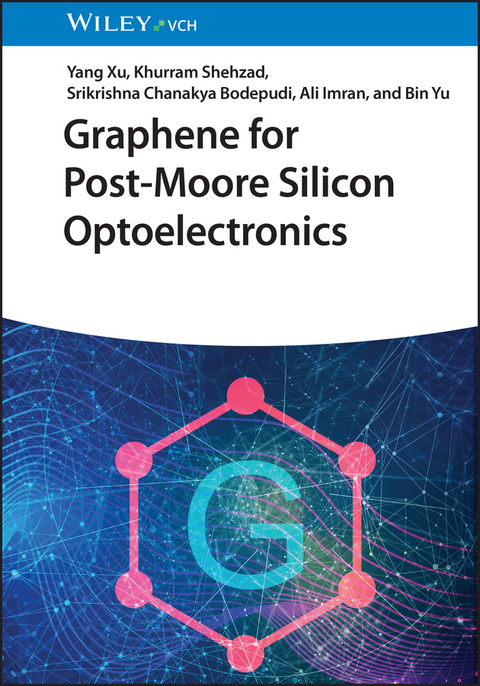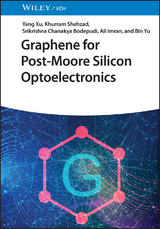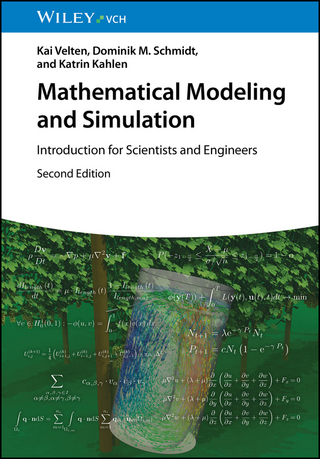Graphene for Post-Moore Silicon Optoelectronics
Wiley-VCH (Verlag)
978-3-527-35181-7 (ISBN)
Prof. Yang Xu is an IEEE NTC distinguished lecturer and IEEE Senior Member of the Electron Devices Society. He received his B.S degree in ECE from Tsinghua University and Ph.D. degree in ECE from the University of Illinois Urbana-Champaign (UIUC), USA in 2009. He is a full professor since 2016 and is now appointed as Assistant Dean at the School of Micro-Nano Electronics, Zhejiang University, China. He was also a Fellow of Churchill College at the University of Cambridge, UK, and a visiting professor at the University of California Los Angles (UCLA). He has published more than 120 papers including Nature Nanotechnology, Nature Electronics, Nature Photonics, Chemical Reviews, Advanced Materials, Chemical Society Reviews, Nature Communications, Nano Letters, ACS Nano, and IEDM with citations over 4200 times and a H-index of 35. He holds over 30 granted patents and gave more than 50 talks in IEDM, MRS, APS and ICPS conferences. He also served as the TPC and committee members of IEEE, AIP, and IOP conferences. His current research interests include emerging low-dimensional smart sensors and photodetectors for internet-of-things and flexible electronics.Khurram Shehzad obtained his Ph.D. in Materials Science and Engineering in 2011 from Beijing University of Chemical Technology. From 2011 to 2013, he was a postdoctoral fellow at the center for nano and micromechanics, Tsinghua University. He joined Zhejiang University as a postdoctoral fellow in 2014. He served as a Research Associate Professor at the School of Micro-Nano Electronics, Zhejiang University, China, and as an associated faculty at Zhejiang University?Hangzhou Global Scientific and Technological Innovation Center. His current research interests include 2D materials/Si hybrids for applications in energy, healthcare, and electronics.Srikrishna Chanakya Bodepudi is a Distinguished Research Fellow at the School of Micro-Nano Electronics, Zhejiang University, China (2018?now). He received a Ph.D. degree from University of Alberta, Canada (2016). In 2017?2018, he worked as a research associate and a course instructor in the Department of Electrical Engineering, University of Alberta. He is the recipient of the NSFC Young Scientists Fund. His current research interests include bulk 2D materials for optoelectronic and memory circuits for applications in energy, healthcare, and data storage.Dr. Ali Imran obtained M.S. from Center of Excellence in Solid State Physics, University of the Punjab Lahore and Ph.D. from School of Optics and Photonics, Beijing Institute of Technology. He is the recipient of Distinguished International Student award from Beijing Institute of technology. He worked as the postdoctoral fellow at State Key Lab of Micro and Mesoscopic Physics, School of Physics, Peking University. Currently, he is perusing his research at School of Micro and Nano Electronics, Zhejiang University. Bin Yu received his Ph.D. degree in Electrical Engineering from the University of California at Berkeley. His current research interests include nanoelectronics, sensors, and neuromorphic devices. Specific interests include post-Si devices, carbon-based electronics, neuromorphic vision, image sensors, and other emerging devices. He has authored or co-authored 8 book/book chapters and over 280 research papers and was the speaker of more than 150 invited talks to international conferences, universities, professional societies, and industries around the globe. Dr. Yu served on the invited panels and advisory/organizing/technical program committees of many international conferences. He was/is Editor of IEEE Electron Devices Letters, Associated Editor of IEEE Transactions on Nanotechnology, Editor of Nano-Micro Letters, and Guest Editor of IEEE Transactions on Electron Devices and IEEE Transactions on Nanotechnology. He is a Fellow of IEEE, a Fellow of the National Academy of Inventors, and the recipient of IEEE Distinguished Lectureship and IBM Faculty Award.
1 INTRODUCTION OF GRAPHENE FOR SILICON OPTOELECTRONICS
1.1 Introduction
1.2 Optical Absorption
1.3 Emergence of Graphene in Silicon Optoelectronics
1.4 Photodetection in Graphene
1.5 Outlook
2 GROWTH AND TRANSFER OF GRAPHENE FOR SILICON OPTOELECTRONICS
2.1 Introduction
2.2 Growth of Graphene
2.3 Dielectric deposition on Graphene
2.4 Graphene Transfer Methods
2.5 Fabrication of Solution Processed Graphene and Integration with Silicon
2.6 Graphene Transfer on Flexible Silicon
2.7 Graphene integration with Silicon CMOS Process
2.8 Challenges and Future Perspectives
3 PHYSICS OF GRAPHENE/SILICON JUNCTIONS
3.1 Introduction
3.2 Physics of Schottky Junction
3.3 Measurement of Schottky Barrier Height
3.4 2D Materials and Schottky Junctions
3.5 Challenges and Future Perspectives
4 GRAPHENE/SILICON JUNCTION FOR HIGH PERFORMANCE PHOTODETECTORS
4.1 Introduction
4.2 Ultraviolet Photodetectors
4.3 Visible to Near Infrared Photodetectors
4.4 Broadband Photodetectors
4.5 Hybrid Graphene/Silicon Photodetectors
4.6 Challenges and Perspectives
5 GRAPHENE/SILICON SOLAR ENERGY HARVESTING DEVICES
5.1 Introduction
5.2 Photovoltaic Mechanism and Performance Parameters in Graphene/Silicon Solar Cells
5.3 Theoretical Efficiency Limits of Graphene/Silicon Solar Cells
5.4 Optimization of Graphene/Silicon Solar Cells
5.5 Challenges and Perspectives
6 GRAPHENE SILICON INTEGRATED WAVEGUIDE DEVICES
6.1 Introduction
6.2 Hybrid Waveguide Photodetector
6.3 Hybrid Waveguide Modulator
6.4 Challenges and Perspectives
7 GRAPHENE FOR SILICON IMAGE SENSOR
7.1 Introduction
7.2 Quantum Dot based Infrared Graphene Image Sensor
7.3 Graphene Thermopile Image Sensor
7.4 Graphene THz Image Sensor
7.5 Curved Image Sensor Array
7.6 Neural Network Image Sensors
7.7 Graphene Charge Coupled Device Image Sensor
7.8 Graphene Based Position Sensitive Detector
7.9 Challenges and Perspectives
8 SYSTEM INTEGRATION WITH GRAPHENE FOR SILICON OPTOELECTRONICS
8.1 Introduction
8.2 Graphene Silicon Flip Chips
8.3 Graphene Silicon Heterogeneous Integration
8.4 Graphene Silicon Monolithic Integration for Optoelectronics Applications
8.5 Challenges and Prospective
9 GRAPHENE FOR SILICON OPTOELECTRONIC SYNAPTIC DEVICES
9.1 Introduction
9.2 Silicon Neurons
9.3 Synaptic devices
9.4 Silicon Optoelectronic Synaptic Devices
9.5 ORAM Synaptic Devices
9.6 Graphene for Silicon Synaptic Devices
9.7 Synaptic Phototransistor
9.8 Mechano-photonic Synaptic Transistor
9.9 Challenges and Prospects
10 CHALLENGES AND PROSPECTS OF GRAPHENE/SILICON OPTOELECTRONICS
10.1 Emergence of Wafer Scale Systems
10.2 Wafer Scale Synthesis and Foundry Process
10.3 Scalable Transfer and Quality Metrics
10.4 Scaling Laws and Hot Electron Effects
10.5 Optical Modulators
10.6 Infrared Photodetectors
10.7 Neuromorphic Optoelectronics
| Erscheinungsdatum | 22.02.2023 |
|---|---|
| Verlagsort | Weinheim |
| Sprache | englisch |
| Maße | 170 x 244 mm |
| Gewicht | 528 g |
| Themenwelt | Naturwissenschaften ► Chemie |
| Technik ► Elektrotechnik / Energietechnik | |
| Technik ► Maschinenbau | |
| Schlagworte | Anorganische Chemie • Chemie • Chemistry • Components & Devices • Electrical & Electronics Engineering • Electronic materials • Elektronische Materialien • Elektrotechnik u. Elektronik • Inorganic Chemistry • Komponenten u. Bauelemente • Materials Science • Materialwissenschaften • Optoelektronik • Physical Chemistry • Physikalische Chemie • Silizium |
| ISBN-10 | 3-527-35181-7 / 3527351817 |
| ISBN-13 | 978-3-527-35181-7 / 9783527351817 |
| Zustand | Neuware |
| Informationen gemäß Produktsicherheitsverordnung (GPSR) | |
| Haben Sie eine Frage zum Produkt? |
aus dem Bereich




